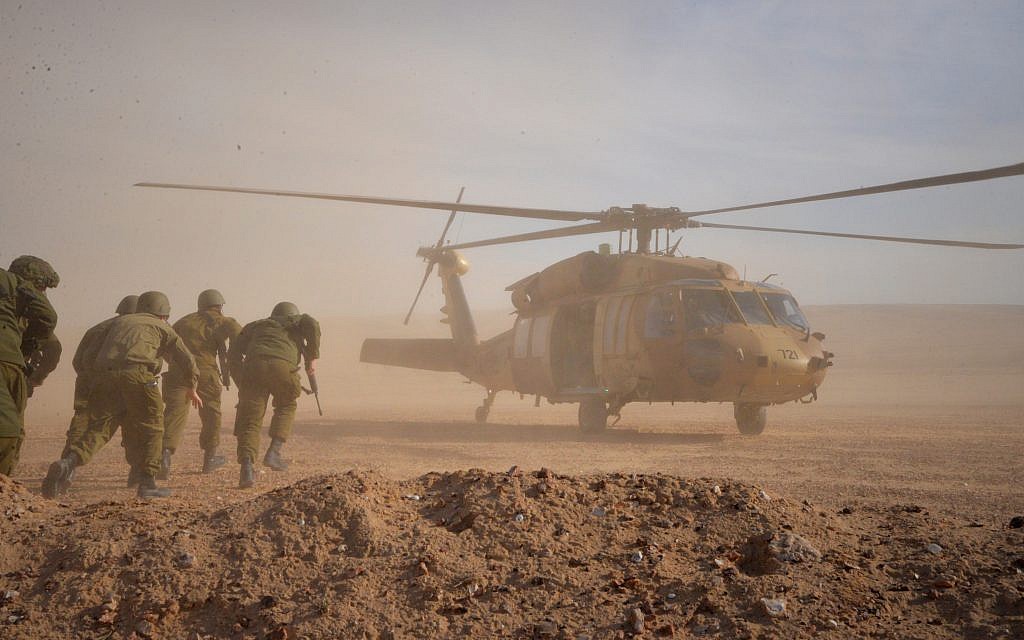 Simulating war with Hezbollah, IDF looks to avoid past mistakes
Simulating war with Hezbollah, IDF looks to avoid past mistakes
JUDAH ARI GROSS
After war games with mock terrorist ‘killing sprees’ in Israeli communities and a counterattack in southern Lebanon, army bringing to a close its largest drill in 19 years

After a week of beating back simulated Hezbollah raids on border communities and responding to fake rocket fire over much of Israel, the IDF went on a mock offensive in southern Lebanon, as the military’s largest exercise in nearly two decades came to a culmination on Monday, a senior IDF officer said.
Last week, the army launched its largest drill since 1998, with tens of thousands of troops drilling for a war with the Hezbollah terrorist group, which the army considers to be its main threat.
The war game was run by the head of the IDF’s Northern Corps, Maj. Gen. Tamir Hyman. It included both physical actions and maneuvers by foot soldiers, land vehicles, naval vessels, helicopters and planes (including jets that reportedly broke the sound barrier over southern Lebanon), as well as computer models.
The exercised was named “Or HaDagan” after Meir Dagan, a former Mossad chief and IDF general who died last year.
In the simulation, war was sparked by a Hezbollah incursion into Israel, followed by rocket fire. “The exercise began on the defensive, with a Hezbollah initiated attack, in which it crossed the Blue Line and infiltrated [Israeli communities],” the officer said late Monday night, speaking on condition of anonymity.
“There were raids on communities near the border, killing sprees in some places,” he said.
The military focused on defending the towns along the border, practicing the evacuation first of the ones lying within four kilometers of the border with Lebanon, and working outwards to nine kilometers from the frontier.
According to the officer, this included everything up to, but not including, moving residents out of their homes, as the army did not want to disrupt the routines of local residents during this specific drill.
After the initial focus on defense, this week the army went on the attack, pretending to conduct ground maneuvers in southern Lebanon, using the similar terrain of northern Israel.
The drill will technically continue through Thursday, but is “scaling down considerably” starting Tuesday, the officer said.
Israel last fought a full-scare war with Hezbollah in 2006’s Second Lebanon War, and tensions have remained high even as the northern border has remained relatively quiet since.
This exercise was touted as a chance to practice failures or military shortcomings exposed during the war.
Led by Hassan Nasrallah, Hezbollah is believed to have an arsenal of between 100,000 and 150,000 short-, medium- and long-range missiles and a fighting force of some 50,000 soldiers, including reservists.
It is seen by the IDF as its main threat, representing the standard by which the Israeli army measures its preparedness.
While military officers often discuss a future conflict with the terrorist group as a matter of “when, not if,” the assessment of the IDF is that Hezbollah is not currently interested in renewed warfare with Israel at present, due to its active involvement in the Syrian civil war, which have caused it significant strategic problems.
Focus on cooperation
In Brig. Gen. (res.) Gal Hirsch’s book on the Second Lebanon War — “A Story of War, a Story of Love,” in Hebrew; “Defensive Shield,” in English — the former commander of a Northern Command division, who played a key role in the conflict, lays out many of the military’s failings: communication issues, intelligence not reaching commanders in the field and an over-reliance on air power.
While the past 11 years of quiet on the northern border are seen as a direct result of the conflict, within the military the war marks a point of negative comparison. “We’re much better since the Second Lebanon War” is a common remark from IDF officers.
The main focus of this month’s drill was therefore cooperation, the officer said, both within the Ground Forces and between the Ground Forces, Air Force and Navy.
read mores: Simulating war with Hezbollah …
twoje uwagi, linki, wlasne artykuly, lub wiadomosci przeslij do: webmaster@reunion68.com
